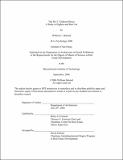| dc.contributor.advisor | Brian A. Ciochetti. | en_US |
| dc.contributor.author | Bolstad, William C. (William Charles) | en_US |
| dc.contributor.other | Massachusetts Institute of Technology. Dept. of Architecture. | en_US |
| dc.date.accessioned | 2007-06-27T20:26:27Z | |
| dc.date.available | 2007-06-27T20:26:27Z | |
| dc.date.copyright | 2006 | en_US |
| dc.date.issued | 2006 | en_US |
| dc.identifier.uri | http://dspace.mit.edu/handle/1721.1/37439 | en_US |
| dc.identifier.uri | http://hdl.handle.net/1721.1/37439 | |
| dc.description | Thesis (S.M.)--Massachusetts Institute of Technology, Dept. of Architecture, 2006. | en_US |
| dc.description | This electronic version was submitted by the student author. The certified thesis is available in the Institute Archives and Special Collections. | en_US |
| dc.description | Includes bibliographical references (p. 95-97). | en_US |
| dc.description.abstract | Since the 1950's, the Massachusetts Institute of Technology has been in possession of the Endicott House, a 19-acre property and former family estate located in Dedham, MA. A highest and best use analysis was performed on the subject site in an effort to determine which of several potential uses would yield the highest potential profit. Three major scenarios including selling the property as it exists currently, subdividing it and selling vacant lots for single-family homes and subdividing the property, constructing single-family homes and selling them were examined. Values for differing scenarios were derived in several ways, making sure to use the appropriate methods for each. These methods included discounted cash flow analysis, the sales comparison technique and assessed value to actual sales price ratio approach. In general, costs for scenarios involving the improvement of real estate were derived with the assistance of a development company with over 25 years of experience and specializing in the construction and sale of single-family homes and planned communities. | en_US |
| dc.description.abstract | (cont.) When estimated costs and expected sales returns were compared, a maximum development alternative was found to generate the highest potential profit. This scenario, which entailed the demolition of the majority of existing facilities and the construction of 14 new single-family homes, resulted in a projected value of $27.2 million by 2010. Research was also conducted on the market potential for development of senior housing facilities at the Endicott House site. Analysis of a 272 square mile study area suggested that the greatest opportunity in this housing market exists in the development of independent senior living units and in dementia care facilities. Suggestions for areas of further study were made. | en_US |
| dc.description.statementofresponsibility | by William C. Bolstad. | en_US |
| dc.format.extent | 98 p. | en_US |
| dc.language.iso | eng | en_US |
| dc.publisher | Massachusetts Institute of Technology | en_US |
| dc.rights | M.I.T. theses are protected by copyright. They may be viewed from this source for any purpose, but reproduction or distribution in any format is prohibited without written permission. See provided URL for inquiries about permission. | en_US |
| dc.rights.uri | http://dspace.mit.edu/handle/1721.1/37439 | en_US |
| dc.rights.uri | http://dspace.mit.edu/handle/1721.1/7582 | |
| dc.subject | Architecture. | en_US |
| dc.title | The M.I.T. Endicott House : a study in highest and best use | en_US |
| dc.title.alternative | Massachusetts Institute of Technology Endicott House : a study in highest and best use | en_US |
| dc.type | Thesis | en_US |
| dc.description.degree | S.M. | en_US |
| dc.contributor.department | Massachusetts Institute of Technology. Department of Architecture | |
| dc.identifier.oclc | 123421617 | en_US |
